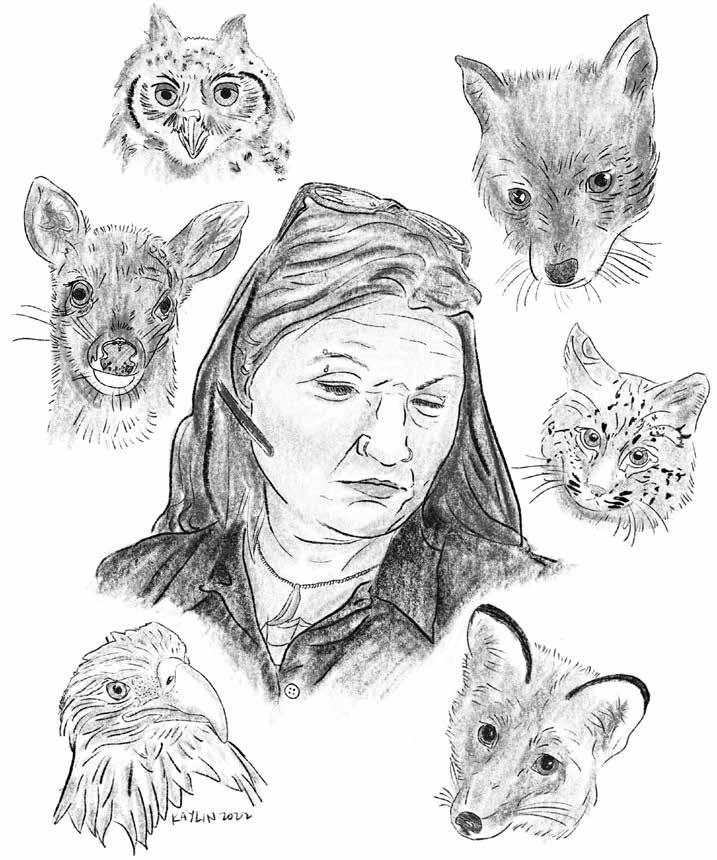
5 minute read
To the rescue
Holding out for a Hero
This Independence org gives at-risk Iowa wildlife a second chance.
Advertisement
bY ErIN CASEY
When pets get sick or injured, they go to the vet. But what happens to wildlife like owls, coyotes and deer when their lives hang in the balance? Tracy Belle, director and founder of Wildthunder Wildlife & Animal Rehabilitation and Sanctuary (W.A.R.S.) comes to their rescue, alongside her team of generous volunteers. From baby raccoons to majestic bald eagles, Wildthunder W.A.R.S. strives to give every animal a new lease on life.
Located in Independence, Iowa, Wildthunder W.A.R.S. is a 501(c)(3) nonprofit organization that’s both state and federally licensed in animal welfare and rescue. At the helm is Belle, a masterclass wildlife rehabilitator who has been saving wildlife for over 25 years. The organization works with many injured and orphaned species, including bobcats, coyotes, foxes, deer, reptiles, bats, raptors and more! The organization’s ultimate goal is to follow treatment and rehabilitation of these animals with reintroducing them to, and eventually releasing them back into, their natural environments.
Belle’s own story is a difficult one, laced with hope.
“I’m a previous homeless street kid,” Belle said as she explained why she was drawn to helping animals. “I left home at 15 and was basically homeless until I was 18 … I learned what it was like to be scared, hungry, alone and unwanted.”
She was introduced to caring for animals after she stayed with rehabilitators in the ’80s, but really dove into it in 1995. She studied under a masterclass wildlife rehabilitator and joined the raptor academy at the University of Minnesota, where she studied raptor medical care, management and release, as well as ambassador care. After school, Belle started Wildthunder W.A.R.S. in 2000, which became a nonprofit in 2016.
She sees a direct line between her struggles of growing up homeless and her organization.
“We usually work with the animals that nobody else will … to give them a second chance,” she said. “It was a path I was put on so I could help others today. I want others to know they’re not alone.”
With the help of volunteers and the community, Wildthunder W.A.R.S. has turned into an
Kaylin Butterfield / Little Village
incredible care center with a medical suite complete with anesthesia machines, metal operating tables, incubators, oxygen chambers and more. Volunteers are vital to its growth, and Belle is always looking for people to tend to lawnwork, build and modify enclosures, and help the animals.
At the end of November, they’ll unveil their new 100-foot flight pen. This will give falcons, hawks, eagles and other raptors the chance to exercise their wings before they go back out into the wild. The facility also has access to acres of wooded area and streams where rehabilitated animals are released.
Of course, running a facility like this comes with a big bill. Generous donations from the community keep the lights on, the medical machines running and the animals fed.
They also partner with other organizations like Saving Our Avian Resources (SOAR) in Dedham, Iowa, and work alongside humane societies and the local sheriff’s office to bring in injured and unwanted animals. So if you find an injured critter, be sure to reach out. While it’s tempting to treat the animal yourself, it’s best to leave it in the hands of the
“I LEFT HomE AT 15 AND WAS experts. bASICALLY HomELESS UNTIL I If you are looking for a new
WAS 18 … I LEArNED WHAT IT furry, feathered WAS LIKE To bE SCArED, HUNGrY, or scaled friend,
ALoNE AND UNWANTED.” several animals are currently up for adoption at Wildthunder W.A.R.S. And if you can’t bond with one there, Belle strongly encourages people to adopt from local rescues and shelters. When Wildthunder W.A.R.S. isn’t busy with their patients, they’re leading informational sessions at libraries and state parks. They even teach classes, like Pet CPR, at their educational center. Running a rehab center isn’t always pretty.
While the hope is to return all animals to the wild, not every patient survives. Belle explained that TV and Hollywood give a false impression of what actually happens at rehab centers.
“[People] see this animal come in, and you have this big beautiful release, but what people don’t understand is, that’s not the percentage. They don’t understand the broken birds, the broken animals, the maggot infestation … they don’t get the percentage of the days that you feel like you can’t keep doing this,” Belle said.
Volunteers may spend weeks caring for an animal only to have it regress. Sometimes patients recover, but due to a debilitating injury that would make living in the wild nearly impossible, they’re euthanized humanely. It may be a difficult thing to hear, but not every animal can be turned into an ambassador for the facility. If there’s no quality of life, the kindest thing to do is to end their suffering.
Luckily, many stories don’t end in tragedy. Belle fondly recalled the rehab of a newborn deer named Stinky due to the smell of his wound.
“He had a skull fracture. He had one eye that he couldn’t properly blink, and that was a concern. But one-eyed deer can survive! He integrated into the herd very well. Later on that fall, we released him, and we have pictures of Stinky trotting away with the rest of the deer.”
Stinky is just one of many animals Belle and her team have rescued. A snake named Big Hoss was found as a stray in Waterloo. He had pneumonia and wasn’t expected to live. But after a few weeks of extensive treatment under just the right temp and humidity, he fully recovered.
Some cases are even more challenging.
“Scrimshaw came to us a teeny, tiny baby raccoon,” Belle said, adding that he had been bitten deeply. “[He] had holes in his face, and as he got bigger, he would eat and water would come out!”
Despite all this, and after much medical care, he could still manage to get fish and wintered over at the facility. A doghouse served as a cave, and he would poke his head out to get food. Like Stinky and Big Hoss, Scrimshaw survived and rejoined the wild.
Success stories are what keep Belle and her volunteers going. You can watch many incredible releases on their Facebook page.
Without Wildthunder W.A.R.S., countless animals would go through needless suffering, or never find a way back to the woods. Fortunately, Belle and her team are there to save the day.
Erin Casey (she/her), an urban fantasy author and a founder of the Writers’ Rooms, once spent several months volunteering at a raptor rescue center. (erincasey.org)












